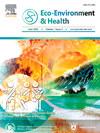A more scientific blood lead reference value urgently needs to be updated in China: From a national and international insight
引用次数: 0
Abstract
Although blood lead levels (BLLs) in children have significantly decreased compared to two decades ago, incidents of lead poisoning and elevated BLLs among children continue to occur frequently. This trend suggests that China's current hygienic regulations are not sufficiently effective in managing children's lead exposure. This study analyzed the revision processes of blood lead reference values (BLRVs) in children from various countries, the current BLLs and their changing trends in China, potential sources of lead pollution and exposure, the requirements for managing and protecting children's health, as well as the national measures and strategies for lead emission management and control. The study also explored the necessity and urgency of updating China's BLRVs in children. Based on the specific conditions in China, a proposed BLRV of 50 μg/L was deemed more reasonable and was suggested for implementation, with the potential to yield substantial economic benefits through improved IQ outcomes should the updated BLRV be adopted.

中国迫切需要更新更科学的血铅参考值:从国家和国际的角度来看
尽管与二十年前相比,儿童血铅含量(BLLs)已明显下降,但儿童铅中毒和血铅含量升高的事件仍时有发生。这一趋势表明,中国现行的卫生法规在管理儿童铅暴露方面不够有效。本研究分析了各国儿童血铅参考值(BLRVs)的修订过程、中国目前儿童血铅参考值(BLLs)及其变化趋势、潜在的铅污染源和铅暴露、儿童健康管理和保护要求以及国家铅排放管理和控制措施和策略。研究还探讨了更新中国儿童铅含量参考值的必要性和紧迫性。根据中国的具体国情,认为 50 μg/L 的铅含量参考值更为合理,建议予以实施。
本文章由计算机程序翻译,如有差异,请以英文原文为准。
求助全文
约1分钟内获得全文
求助全文
来源期刊

Eco-Environment & Health
环境科学与生态学-生态、环境与健康
CiteScore
11.00
自引率
0.00%
发文量
18
审稿时长
22 days
期刊介绍:
Eco-Environment & Health (EEH) is an international and multidisciplinary peer-reviewed journal designed for publications on the frontiers of the ecology, environment and health as well as their related disciplines. EEH focuses on the concept of “One Health” to promote green and sustainable development, dealing with the interactions among ecology, environment and health, and the underlying mechanisms and interventions. Our mission is to be one of the most important flagship journals in the field of environmental health.
Scopes
EEH covers a variety of research areas, including but not limited to ecology and biodiversity conservation, environmental behaviors and bioprocesses of emerging contaminants, human exposure and health effects, and evaluation, management and regulation of environmental risks. The key topics of EEH include:
1) Ecology and Biodiversity Conservation
Biodiversity
Ecological restoration
Ecological safety
Protected area
2) Environmental and Biological Fate of Emerging Contaminants
Environmental behaviors
Environmental processes
Environmental microbiology
3) Human Exposure and Health Effects
Environmental toxicology
Environmental epidemiology
Environmental health risk
Food safety
4) Evaluation, Management and Regulation of Environmental Risks
Chemical safety
Environmental policy
Health policy
Health economics
Environmental remediation
 求助内容:
求助内容: 应助结果提醒方式:
应助结果提醒方式:


